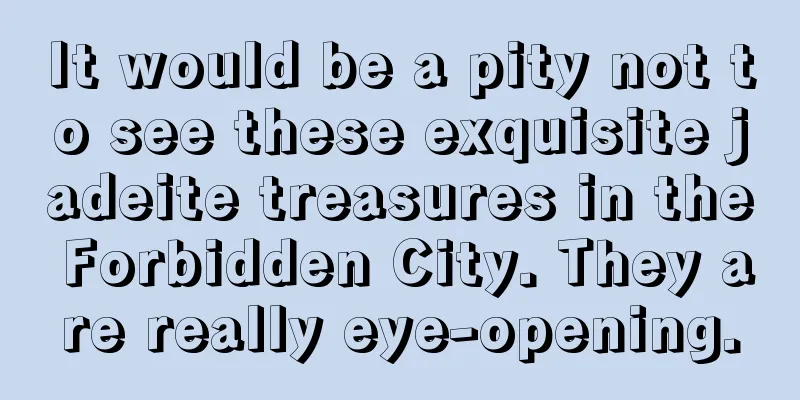It would be a pity not to see these exquisite jadeite treasures in the Forbidden City. They are really eye-opening.

|
In recent years, as the popularity of jade has continued to soar, jade culture has also been thriving. In the history of the development of jade culture, there are countless classic jades hidden in palaces. Today, some classic jades have disappeared, while others are still treasured in museums. The jade collections in the Forbidden City are mainly relics from the Qing Palace, including more than 20 imperial seals and empress seals, more than 400 pieces of jewelry, and more than 300 other artifacts. There were very few jadeite artifacts during the Yongzheng period, but the number of artifacts gradually increased during the Qianlong period. The largest number of jadeite artifacts were collected during the reign of Empress Dowager Cixi in the late Qing Dynasty... A Gilded Copper Octagonal Box Inlaid with Jadeite from the Qianlong Period of the Qing Dynasty This jade product is green all over, it should be old pit jade seed material, and its exquisite workmanship is amazing. It is a work of art when it is placed casually. Qing Dynasty Pearl and Jade Gemstone Headpiece This piece of jewelry is inlaid with jade, pearls, gemstones, etc. The materials are exquisite, and the craftsmanship at that time is not inferior to today's big brands. A jade nine-lion lidded censer made by Emperor Guangxu of the Qing Dynasty This incense burner is carved from jade and consists of two parts: the cover and the body. The whole piece has a solemn and generous shape, a simple and elegant style, fine carvings and elaborate decorations, reflecting the distinctive characteristics of the court jade carving craftsmanship in the late Qing Dynasty. It is also an important material evidence of the royal jade-loving custom in the late Qing Dynasty. Empress Dowager Cixi Jade Snuff Bottle This Qing Dynasty carved jade snuff bottle is made of icy jade. The body of the bottle is emerald green and has a lustrous texture. The shallow relief carvings of mountains, rocks, chrysanthemums and orchids are full of vitality, just like a vivid flower painting. The top of the snuff bottle, or the lid, is made of pink tourmaline. The overall shape of the snuff bottle is beautiful and elegant, the carving technique is round, the workmanship is exquisite, and it has a strong Qing Dynasty court style. Emperor Qianlong's Tourmaline Jade Ruyi This jade Ruyi is emerald green. The Ruyi is in the shape of a Ganoderma lucidum, with the handle made into a Ganoderma lucidum branch, twigs and leaves carved out, and a small Ganoderma lucidum decorated at the bottom of the handle, making it look noble and elegant. Jadeite eighteen beads bracelet The circumference of the bracelet is 28 cm. The jade is tender green and flawless, lustrous and moist. It is made of 18 round beads, so it is called the "18-bead bracelet". According to legend, it was a gift from Huang Taiji to Empress Chen, and later became a burial item for Cixi! There is also a tragic love story hidden in it. Gold and Jade Hairpin The head of the hairpin is shaped like a hand, with slender fingers, long nails, and a white jade bracelet on the wrist. Such exquisite carvings show the superb skills of the craftsmen! It not only has a unique shape, but also uses very exquisite materials. Six round pearls and a blue crystal pendant are hung under the emerald ring of the Ruyi head. It combines gold, jade, pearls, emerald and crystal in one, making it extremely precious. Jadeite feather tube Jadeite feather tubes were a symbol of identity and status in the Qing Dynasty. This feather tube is 6.5 cm long, 1.4 cm in diameter and 0.8 cm in hole diameter. It is now in the collection of Jiujiang City Museum. The whole body is emerald green, with a few impurities on the top, and the material is very rare. Jadeite ring Looking at the ring as a whole, you can see that it is emerald green all over and very transparent. It is 2.5 cm high and 3 cm in diameter. It was unearthed in 1966. It was Li Lianying's favorite item during his lifetime and is worth over 100 million yuan. Qing Dynasty Jadeite Imperial Beads This Qing Dynasty jadeite court rosary is composed of 108 jadeite round beads, 4 tourmaline Buddha heads and a gold-backed cloud, with a Buddha head between 27 beads. The gold-backed cloud is in the shape of a ruyi and is embedded with gems. It was a unique accessory for official uniforms in the Qing Dynasty. Nowadays, jade has both classical elements and popular elements, and wearing jade has become a trend. Although the classic ornaments mentioned above no longer appear in our lives, their existence is of milestone significance to jade culture!
fruit fcgc33 |
>>: Why is jade often paired with diamonds? Don’t like playing with other jades?
Recommend
Detailed explanation of jadeite colors, don’t think that only green jadeite is valuable!
As we all know, in addition to its quality, color...
On a whim, a young man spent 3,000 yuan to buy jadeite rough stone online, but with one cut, it turned out to be "black chicken type"?
Originally, black was considered a dirty color fo...
Tips on choosing jadeite raw materials that you won’t sell even if you are offered a million
If we have worked in several different fields, we...
How are the purple grades of Emerald Violet differentiated?
Violet jade symbolizes eternal beauty, which is o...
Reveal the secrets of jadeite optimization processing!
Jadeite. We all know that the best jadeite is A-g...
The most complete information on "Emerald Green Jadeite" is worth collecting
At Poly's Spring Auction's Brilliant Jewe...
A humble piece of jadeite can be carved into an extraordinary jadeite work
Ice-type colored flakes, good quality, good water...
What exactly is dry green jadeite? Is it considered jadeite?
As the saying goes, jade is most valuable when it...
Burmese jadeite, jade cannot be made into a useful object without being carved, it requires good material and excellent workmanship!
As the saying goes, jade cannot be made into a us...
The difference between the authenticity of the rare "black jadeite", are you still buying fakes?
Black jade is a rare variety of jade. It is gradu...
Why are some carvings expensive while others are cheap?
Good material quality Jade carvings are generally...
Don’t know how to appraise the value of the jadeite in your hand? I'll teach you
Among jade products, plain products are generally...
A small egg, but its value is sky-high. The secret of its production process is revealed
The Value of Jade Egg-shaped Necklace Many friend...
What kind of jade is suitable to give to children?
A pendant can express parents' concern and ca...
Gold vs. Jade, how would you choose?
"Why is it so rare? It jumps off the wrist.&...









